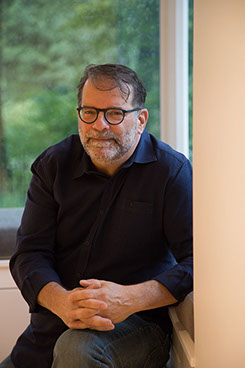John C. Williams, AIA
2018 MID-CAREER ARTIST PRIZE IN DESIGN
Architecture? Not so much. Until he was in his early 20s, and an Australian friend convinced him to tour the Northeast for a couple of weeks, primarily to visit the lone LeCorbusier building in the US: The Carpenter Center for the Visual Arts at Harvard University.

He was looking at this building, thinking, “All right, it’s brutalist, it’s esoteric, Bauhaus architecture, but what is the appeal? I don’t get it,” he says. “I wasn’t converted at all, but it planted a seed.”
The thought of photojournalism as a career lingered, but with one challenge. “I didn’t think I could place a camera in front of someone at a critical point in their life and take a picture,” he explains. “I’m an introvert. That’s too intrusive.”
He continued to enjoy his passion for playing music, collected acoustic instruments and studied guitar design and building in Vermont, planning on becoming a guitar builder. But deep in his mind, that architecture seed had grown. “I hadn’t lost my passion for those other subjects, but with architecture I thought I don’t know anything about it, and it’s constantly evolving,” he recalls. “There was logic to saying I’m going to try this just to see if it resonates because it seemed challenging.”
With characteristic passion and commitment, John dove in head first, completing an entire first year in the ten-week summer architecture program at Kent State University. As part of his studies, he completed an Architecture-intensive program one semester in Florence, Italy, and then traveled through Europe for three months in 1985. He earned his Bachelor of Science degree in Architecture in 1986.
After graduation, John went through the typical period of working for a variety of firms as he matured as a designer, and along the way made and nurtured significant connections, such as Forest City Enterprises, that would come into play later in his career.
In 1993, he received his license to practice architecture, which opened the door for launching his own firm. He landed a residential design project that he knew would cover his expenses, charged a computer and other supplies on his credit card, had his business cards made, and after he picked them up, he resigned.
“That was April 15, 1993, tax day,” he says. “Here I am almost 25 years later, and it feels like five years. I am focused and have goals, but I never thought this far out or with this kind of trajectory when I was younger.”
As the founder of Process Creative Studios, a five-person architectural firm, John has guided his business to acclaim for its far-reaching array of projects in Cleveland. “Everyone wants to label architects and assign a particular project type,” John declares. “I like to say we have a creative lack of focus.”
John has won multiple awards from the American Institute of Architects, the International Interior Design Association, and the Cleveland Restoration Society for a wide variety of projects, including the Palindrome Home, Heinen’s AmeriTrust Rotunda, the Transformer Station and the Century restaurant at the Ritz Carlton.
Not only was John a former board member and president of SPACES Gallery, he was also the designer of their new facility. SPACES Gallery honored him at its 2013 annual benefit. “John is respectful of historic properties but also designs them with a sensitivity to contemporary use,’ says Christina Vassallo, executive director, SPACES Gallery. “He has worked with us to make sure that it balances the needs of an exhibiting venue, along with being able to protect, reveal and celebrate the unique aspects of the building.”
Currently, John serves on the board of the Museum of Contemporary Art and has been a member and president of several other boards, including Roots of American Music and the Cleveland Museum of Art’s Contemporary Arts Society and Friends of Photography.
He graduated in the 2005 class of Leadership Cleveland. He’s also very proud of being inducted into his high school’s Gallery of Distinguished Alumni, especially considering what he described as a “miserably low GPA from that era.”
Cleveland Arts Prize
P.O. Box 21126 • Cleveland, OH 44121 • 440-523-9889 • info@clevelandartsprize.org